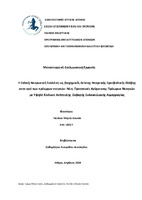New Perspectives for the Identification of Preterm Neonates at High Risk for Severe Intraventricular Hemorrhage
H Ειδική Νευρωνική Ενολάση ως βιοχημικός δείκτης Νεογνικής Εγκεφαλικής Βλάβης στον ορό των πρόωρων νεογνών- Νέες Προοπτικές Ανίχνευσης Πρόωρων Νεογνών με Υψηλό Κίνδυνο Ανάπτυξης Σοβαρής Ενδοκοιλιακής ΑιμορραγίαςSerum Neuron-Specific Enolase as a Biomarker of Neonatal Brain Injury

Μεταπτυχιακή διπλωματική εργασία
Author
Παύλου, Μαρία-Λουκία
Date
2024-05-01Advisor
AVRAMIOTI LYKERIDOU, AIKATERINIKeywords
Serum ; Brain injury ; Preterm neonate ; Biomarkers ; Neuron-specific enolase ; Periventricular leukomalacia ; Neonatal intensive care unit ; Intraventricular hemorrhageAbstract
Εισαγωγή: Η νεογνική εγκεφαλική βλάβη (ΝΕΒ) είναι μια κρίσιμη κατάσταση για τα πρόωρα νεογνά με
δυνητικά δυσμενείς μακροπρόθεσμες νευροαναπτυξιακές εκβάσεις.
Σκοπός : Αυτή η προοπτική διαχρονική μελέτη ασθενών- μαρτύρων έχει σκοπό τη διερεύνηση των επιπέδων
και της προγνωστικής αξίας της Ειδικής Νευρωνικής Ενολάσης (ΕΝΕ) κατά τις τρεις πρώτες ημέρες ζωής στον
ορό πρόωρων νεογνών (<34 εβδομάδων) που αργότερα ανέπτυξαν ΝΕΒ είτε με τη μορφή της Περικοιλιακής
Λευκομαλακίας (ΠΛ) είτε με τη μορφή της Ενδοκοιλιακής Αιμορραγίας (ΕΑ) κατά την διάρκεια της νοσηλείας
τους.
Μέθοδοι : Τα πρόωρα νεογνά που συμμετείχαν, επιλέχθηκαν από μια Μονάδα Εντατικής Νοσηλείας Νεογνών
(ΜΕΝΝ) και με βάση το βάρος γέννησης και την ηλικία κύησης , αντιστοιχήθηκε το κάθε νεογνό -ασθενής
(n=29) με ένα νεογνό - μάρτυρα που είχε φυσιολογικό υπερηχογράφημα εγκεφάλου (n=29).
Αποτελέσματα :Αναφέρεται ότι τα επίπεδα της ΕΝΕ στον ορό κατά τις τρεις πρώτες ημέρες ζωής δεν
διαφέρουν σημαντικά ανάμεσα στην ομάδα μαρτύρων και πρόωρων νεογνών με ΝΕΒ. Παρ’ όλα αυτά η
ανάλυση υποομάδων αποκάλυψε ότι τα νεογνά με ΕΑ είχαν σημαντικά υψηλότερη συγκέντρωση ΕΝΕ στον
ορό σε σχέση με τα νεογνά- μάρτυρες και με ΠΛ την τρίτη ημέρα ζωής (p=0.014 και p=0.033 αντίστοιχα). Το
ίδιο πρότυπο σχετικά με τα επίπεδα της ΕΝΕ την τρίτη ημέρα ζωής παρατηρήθηκε επίσης ανάμεσα : α) στα
νεογνά με ΕΑ και όλα τα άλλα νεογνά (ΠΛ και μάρτυρες ; p=0.003) , β) στα νεογνά με II-IV βαθμού ΕΑ και όλα
τα άλλα νεογνά (p=0.003) και γ) στα νεογνά- μάρτυρες και τα νεογνά που απεβίωσαν από την ομάδα-
ασθενών.
Συμπεράσματα : Συμπεραίνεται ότι η ΕΝΕ θα μπορούσε να είναι ένας αποτελεσματικός και χρήσιμος
βιοχημικός δείκτης κατά την τρίτη ημέρα ζωής για τον εντοπισμό πρόωρων νεογνών υψηλού κινδύνου να
αναπτύξουν σοβαρού βαθμού ΕΑ.
Abstract
Introduction: Neonatal brain injury (NBI) is a critical condition for preterm neonates with potential long-term
adverse neurodevelopmental outcomes.
Materials and Methods: This prospective longitudinal case–control study aimed at investigating the levels and
prognostic value of serum neuron-specific enolase (NSE) during the first 3 days of life in preterm neonates (<34
weeks) that later developed brain injury in the form of either periventricular leukomalacia (PVL) or
intraventricular hemorrhage (IVH) during their hospitalization. Participants were recruited from one neonatal
intensive care unit, and on the basis of birth weight and gestational age, we matched each case (n = 29) with a
neonate who had a normal head ultrasound scan (n = 29).
Results: We report that serum NSE levels during the first three days of life do not differ significantly between
control and preterm neonates with NBI. Nevertheless, subgroup analysis revealed that neonates with IVH had
significantly higher concentrations of serum NSE in comparison to controls and neonates with PVL on the third
day of life (p = 0.014 and p = 0.033, respectively). The same pattern on the levels of NSE on the third day of life
was also observed between (a) neonates with IVH and all other neonates (PVL and control; p = 0.003), (b)
neonates with II–IV degree IVH and all other neonates (p = 0.003), and (c) between control and the five (n = 5)
neonates that died from the case group control (p = 0.023).
Conclusion: We conclude that NSE could be an effective and useful biomarker on the third day of life for the
identification of preterm neonates at high risk of developing severe forms of IVH.

